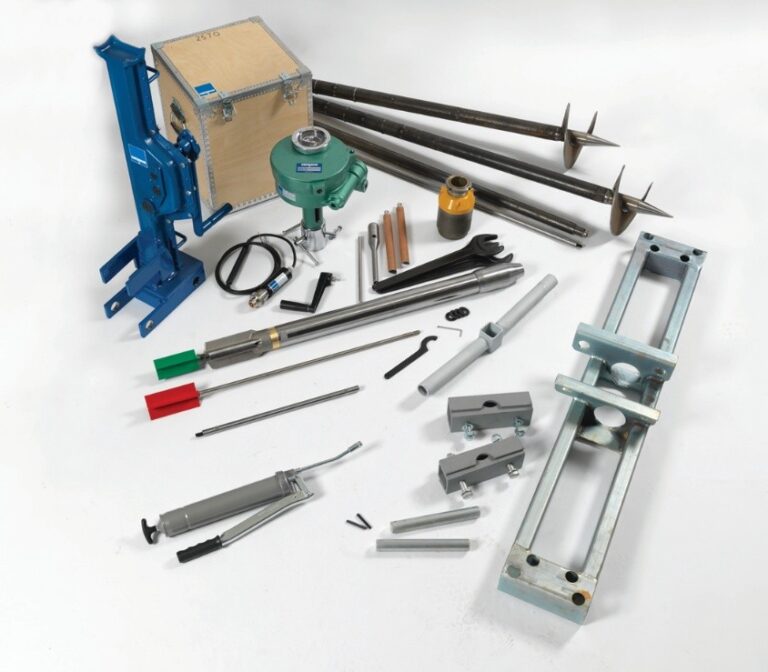
Introduction
The Vane Shear Test (VST) is one of the most practical methods in geotechnical engineering to measure the shear strength of soft cohesive soils such as clay and silt. Engineers perform the test by inserting a vane-shaped tool into the soil and rotating it gradually until the soil fails in shear. Because of its simplicity and efficiency, the test has become a reliable option for both field and laboratory conditions.
What is the Vane Shear Test?
In geotechnical practice, the Vane Shear Test is used to determine the undrained shear strength of very soft, saturated clay. Engineers often select this method when alternative tests such as the direct shear test or the triaxial test cannot be applied due to the soil’s extremely soft consistency.
During the test, a thin four-bladed vane is inserted into the soil. Then, the operator rotates the vane at a controlled rate until the soil fails in shear. The maximum torque recorded at that moment is converted into the soil’s undrained shear strength.
Related article: Safety in Water Well Drilling Operations
Purpose of the Test
The main purpose of the Vane Shear Test is to directly determine the undrained shear strength of soft soils. Engineers can perform this test either in the field or in a controlled laboratory environment. As a result, it provides quick and reliable input for design and stability evaluations.
Working Principle
The test follows a straightforward principle:
First, the operator inserts the vane vertically into the soil.
Next, the vane is rotated slowly at a constant rate (0.1°–0.2° per second).
Then, the torque required to rotate the vane until soil failure occurs is measured.
Finally, engineers calculate the undrained shear strength from the maximum torque value.
By following this sequence, geotechnical teams can assess soil strength efficiently without disturbing the sample.
Why Use the Vane Shear Test?
The Vane Shear Test offers several key advantages compared to other geotechnical tests.
Fast and efficient → Engineers can complete the test in a short amount of time.
Cost-effective → It requires less equipment and preparation compared to triaxial or direct shear tests.
Ideal for very soft clay → Especially useful for saturated clays where sampling is difficult.
On-site application → The test can be performed directly in the field without transporting samples to the lab.
Common Applications
In geotechnical projects, the Vane Shear Test is applied in several areas, such as:
Foundation design for shallow and deep structures
Slope and embankment stability assessments
Bearing capacity analysis for reclamation projects
Preliminary studies for infrastructure development
In each case, the test provides valuable data that supports safe and cost-effective engineering decisions.
Key Equipment
To conduct the Vane Shear Test, engineers typically use the following tools:
Vane – a four-bladed steel tool
Torque rod – for controlled rotation
Torque gauge – to measure applied torque
Stopwatch – to monitor rotation speed
Hand auger or drilling machine – for borehole preparation during field tests
With these tools, the test can be performed both in the field and in laboratory conditions.
Testing Procedures
a. Field Test Procedure
Drill a borehole to the target depth.
Insert the vane vertically into the soil without rotation.
Rotate the vane slowly at a constant rate (0.1°–0.2° per second).
Record the maximum torque at soil failure.
Convert the torque into undrained shear strength.
b. Laboratory Test Procedure
Collect an undisturbed soil sample.
Insert the vane into the sample.
Rotate the vane slowly following the same procedure as in field testing.
Measure the maximum torque at soil failure.
Calculate the undrained shear strength from the torque value.
By following these steps, engineers can ensure consistent and accurate results.
Advantages
The Vane Shear Test is preferred in many cases due to its benefits:
Simple and quick to perform
No need for undisturbed soil sampling in the field
Well-suited for very soft cohesive soils
Limitations
Despite its usefulness, the Vane Shear Test also has certain limitations:
It cannot be applied to sandy or gravelly soils
Results may vary if the soil has been disturbed before testing
The method does not represent actual field drainage conditions
Therefore, geotechnical engineers often combine the Vane Shear Test with other methods for comprehensive soil analysis.

